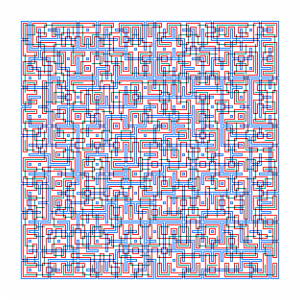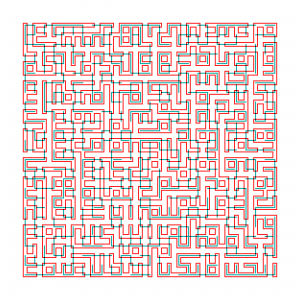Ever wondered how deeply your brain needs to dig to complete a Square Kufic art piece? The amount of work will blow your mind! Let’s do the math.
 Your design is based on a single element: a square. Your job is to redesign letters, words, sentences, or even a paragraph by distributing these squares over a grid of your choice. Sounds easy? Well, it’s not. The number of letters you need to redesign and the number of variants can be enormous and overwhelming, but with a little patience, you can manage. Trust me, you’ve just performed billions of calculations and predictions to finish the job. Our brain is more extraordinary than we think.
Your design is based on a single element: a square. Your job is to redesign letters, words, sentences, or even a paragraph by distributing these squares over a grid of your choice. Sounds easy? Well, it’s not. The number of letters you need to redesign and the number of variants can be enormous and overwhelming, but with a little patience, you can manage. Trust me, you’ve just performed billions of calculations and predictions to finish the job. Our brain is more extraordinary than we think.
Let’s say you have a paragraph of 100 words, and you need to create an artwork on a 53×53 unit grid. On average, each word has about four letters, giving you 400 different letters to fit into the grid. An Arabic letter can have various forms: initial, medial, final, and isolated. In total, the number of basic letter shapes, considering these forms, is 101 different letter shapes. Let’s call each letter form a block.
To design a letter in Square Kufic, you use squares as your base element. There are 29 isolated blocks, each containing a minimum of 3 and a maximum of 30 black squares. There are 22 initial blocks and 22 medial blocks, each containing a minimum of 5 and a maximum of 30 black squares. There are also 28 final blocks, each with a minimum of 5 and a maximum of 30 black squares. In other words, designing one letter requires a minimum of 5 black squares, but most letters you design will average around 12 black squares.
But it doesn’t stop there. While you don’t use white squares, they still exist. White squares are the empty spaces you need to consider to balance the letter design and ensure its relation to adjacent letters is correct, preventing overlaps. So technically, you’re working with both black and white squares simultaneously.
 For each letter you design, you unconsciously calculate all the possible variations and locations of each square within one context, which can reach up to 12! (479,001,600 possibilities). But our brains are more efficient, often picking the best or close to the best solution. Thus, a single word may require billions of calculations. Imagine the operations needed for a sentence, or a whole paragraph within a limited grid! The number of operations required to achieve a 53×53 grid design is astronomical, far beyond traditional methods. This is why our brains are unique, capable of solving this in ways only quantum computing, machine learning, and AI might replicate someday, though it hasn’t been fully tested yet.
For each letter you design, you unconsciously calculate all the possible variations and locations of each square within one context, which can reach up to 12! (479,001,600 possibilities). But our brains are more efficient, often picking the best or close to the best solution. Thus, a single word may require billions of calculations. Imagine the operations needed for a sentence, or a whole paragraph within a limited grid! The number of operations required to achieve a 53×53 grid design is astronomical, far beyond traditional methods. This is why our brains are unique, capable of solving this in ways only quantum computing, machine learning, and AI might replicate someday, though it hasn’t been fully tested yet.
I’ve tried using available AI models and machine learning modules, hoping to solve this, but explaining the problem of designing even one letter to a computer is a monumental task. The number of variants in each equation to design one letter is vast: the number of squares, the form of the letter, adjacent letters, the letter’s position, orientation, connectors, anatomy, direction, relation to previous and next letters, spacing within the letter, and many more factors AI needs to understand. When these variants are present, they double with two adjacent letters. Designing a word means instructing the computer on letter connections from both sides and how to place each letter in conjunction with the surrounding space to match the words around it.
Another challenge is teaching the computer to balance the design of each word, sentence, and paragraph. It might create a letter with 30 squares and another in the same word with 3 squares, disrupting the design balance. I’m not saying it’s impossible, but the amount of instructions needed is immense and complicated.
Your brain, in no time compared to current computer technology, can create a piece without going through all these instructions and equations—or at least without you noticing it. The beauty lies not only in the result but also in the process. Every designer can attest to the joy of fitting a letter here or removing one there. This feeling of achieving a complete design in a grid is beautiful in itself and should inspire us to create more and find ways to harness machine learning, AI, and quantum computing to explore new outputs for this exquisite art form.